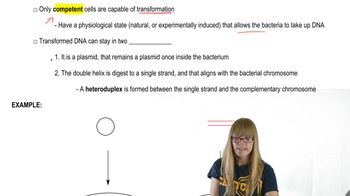Table of contents
- 1. Introduction to Genetics51m
- 2. Mendel's Laws of Inheritance3h 37m
- 3. Extensions to Mendelian Inheritance2h 41m
- 4. Genetic Mapping and Linkage2h 28m
- 5. Genetics of Bacteria and Viruses1h 21m
- 6. Chromosomal Variation1h 48m
- 7. DNA and Chromosome Structure56m
- 8. DNA Replication1h 10m
- 9. Mitosis and Meiosis1h 34m
- 10. Transcription1h 0m
- 11. Translation58m
- 12. Gene Regulation in Prokaryotes1h 19m
- 13. Gene Regulation in Eukaryotes44m
- 14. Genetic Control of Development44m
- 15. Genomes and Genomics1h 50m
- 16. Transposable Elements47m
- 17. Mutation, Repair, and Recombination1h 6m
- 18. Molecular Genetic Tools19m
- 19. Cancer Genetics29m
- 20. Quantitative Genetics1h 26m
- 21. Population Genetics50m
- 22. Evolutionary Genetics29m
5. Genetics of Bacteria and Viruses
Bacterial Transformation
Problem 25a
Textbook Question
Define the term genetic complementation.
Does the term genetic complementation have the same meaning in both cases? Explain.
 Verified step by step guidance
Verified step by step guidance1
<Genetic complementation refers to a phenomenon where two different mutations in the genome of an organism result in a wild-type or non-mutant phenotype when present together.>
<This occurs when the mutations are in different genes, allowing each gene to provide the function that the other lacks.>
<In a genetic complementation test, two organisms with different recessive mutations that produce the same phenotype are crossed.>
<If the offspring display the wild-type phenotype, it indicates that the mutations complement each other, meaning they are in different genes.>
<The term genetic complementation can have different implications depending on the context, such as in diploid organisms versus haploid organisms, but the core concept remains the same: the restoration of a function through the combination of different mutations.>
Recommended similar problem, with video answer:
 Verified Solution
Verified SolutionThis video solution was recommended by our tutors as helpful for the problem above
Video duration:
3mPlay a video:
Was this helpful?

 5:53m
5:53mWatch next
Master Transformation with a bite sized video explanation from Kylia Goodner
Start learningRelated Videos
Related Practice


